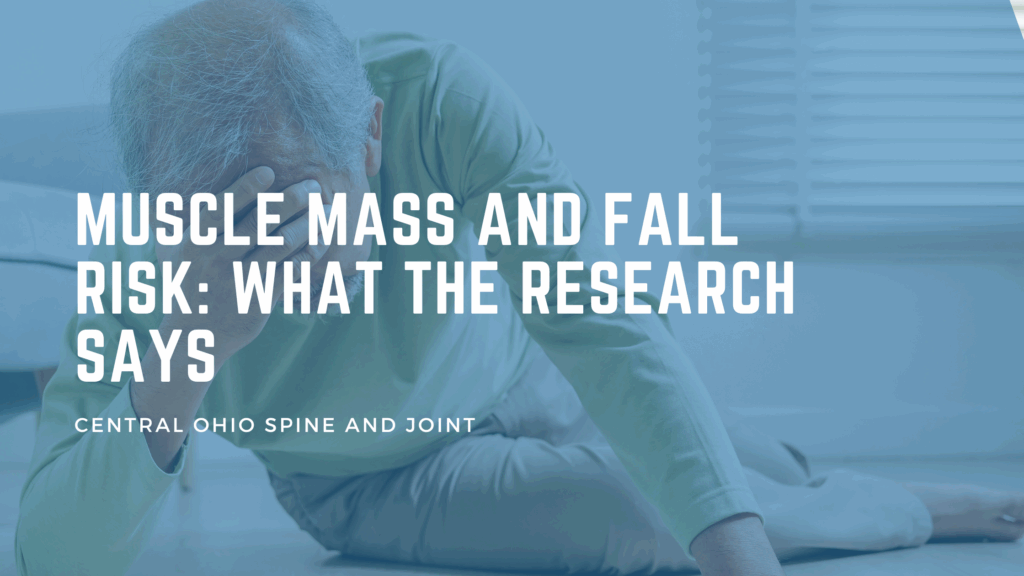Why Muscle Mass Matters as You Age
Muscle mass plays a far more important role in health than most people realize. As we age, we naturally lose muscle—a process known as sarcopenia. Starting around age 30, adults lose an average of 3–8% of muscle mass per decade, and after age 60, this loss can exceed 1% per year unless preventative steps are taken.
But the real danger isn’t just the shrinking of muscle size—it’s what that means functionally. Reduced muscle mass leads to:
- Decreased strength and balance
- Slower reaction times
- Increased joint stress
- Reduced ability to safely recover from trips or missteps
These changes drastically increase the risk of falls, which are the leading cause of both fatal and non-fatal injuries in adults over 65.
The Research: Muscle Mass and Fall Risk
Recent research has made it clear: low muscle mass is one of the strongest predictors of fall risk in older adults.
Key Findings:
- A 2015 meta-analysis published in Age and Ageing found that sarcopenia was significantly associated with an increased risk of falls (odds ratio 1.76).
- A 2020 study in The Journal of Cachexia, Sarcopenia and Muscle found that muscle mass and strength were independently associated with fall risk — even when accounting for age, sex, and other health conditions.
- Research published in The American Journal of Medicine found that low muscle mass was associated with increased frailty, mobility issues, and hospitalization rates.
More than 1 in 4 older adults fall each year, and nearly 1 in 5 of these falls leads to serious injury like fractures or head trauma. These aren’t just physical injuries — they can trigger a loss of confidence, reduced independence, and long-term disability.
Assessing Fall Risk in Our Clinic
At Central Ohio Spine and Joint, we take a proactive approach to fall prevention. Instead of waiting for patients to experience a fall, we assess key functional and physiological markers of fall risk — including muscle mass.
1. InBody 570 Muscle Mass Analysis
We use a medical-grade body composition scanner to evaluate segmental lean mass — meaning how much muscle each area of your body contains (arms, legs, and trunk).
Low lean mass, particularly in the lower body, is a major red flag for fall risk.
2. Grip Strength Testing
Grip strength is a powerful and proven predictor of overall strength, mortality risk, and fall risk. It’s simple to test and gives us insight into whether the nervous system and muscles are firing effectively.
3. 3D Movement and Balance Assessment (Kinetisense)
Our clinic uses motion capture technology to assess:
- Postural control
- Single-leg balance
- Reaction time
- Functional movement deficits
This allows us to identify poor balance mechanics before they lead to a fall.
4. Functional Screening
We look at real-world tasks like:
- Sit-to-stand transfers
- Gait speed
- Stair climbing ability
- Step testing
These functional benchmarks correlate closely with fall risk in the research literature.
Strength-Based Fall Prevention: Our 6-Week Program
Once we identify a patient with elevated fall risk, our goal is to intervene before the next slip or stumble becomes a serious injury. We do this through our 6-Week Strength and Balance Program designed specifically for adults 50+.
What It Includes:
✅ Customized Strength Training
Targeting the lower body (quads, glutes, calves), core, and postural muscles — proven areas to reduce fall risk.
✅ Balance and Stability Exercises
Single-leg stability, dynamic balance drills, and proprioceptive training to improve real-world resilience.
✅ Mobility Work
Tight hips, ankles, and thoracic spines can all disrupt balance — we address these limitations with mobility drills.
✅ Neuromuscular Coordination
We train the brain as much as the body — using drills that improve reaction time, movement control, and confidence.
✅ Objective Progress Tracking
We re-test muscle mass, balance metrics, and strength to prove improvement and build confidence.
Real-Life Impact: A Patient Story
One of our recent participants was a 74-year-old woman who had fallen twice in the last year. She’d stopped walking in the evening due to fear of falling and had noticeable muscle loss in her legs.
After completing our 6-week program:
- She gained 3.2 lbs of lean muscle (InBody)
- Improved her single-leg balance by 50%
- Reported walking more often and feeling more confident and steady
This type of result isn’t uncommon — it’s what happens when patients are given a structured, research-driven plan and the support to follow through.

How You Can Take Action
Falls aren’t a normal part of aging — they’re a preventable, treatable condition with the right plan. If you or a loved one are over 50 and haven’t had your muscle mass or fall risk assessed, now is the time.
You should consider a fall risk assessment if:
- You’ve had a fall or near-fall in the past year
- You feel unsteady on your feet
- You’ve noticed weakness, slower movement, or trouble getting up from a chair
- You’ve reduced your activity out of fear of falling
The Bottom Line
Muscle mass isn’t just about looking fit — it’s about protecting your ability to live independently, move confidently, and reduce your risk of injury. Research confirms that maintaining and rebuilding muscle is one of the most powerful tools for fall prevention.
At our clinic, we combine objective testing with evidence-based training programs to keep you stronger, steadier, and safer — no matter your age.
Want to Know Your Fall Risk?
Schedule a $49 Diagnostic Fall Risk Assessment today — includes InBody scan, movement testing, and a personalized action plan.

Recent Comments